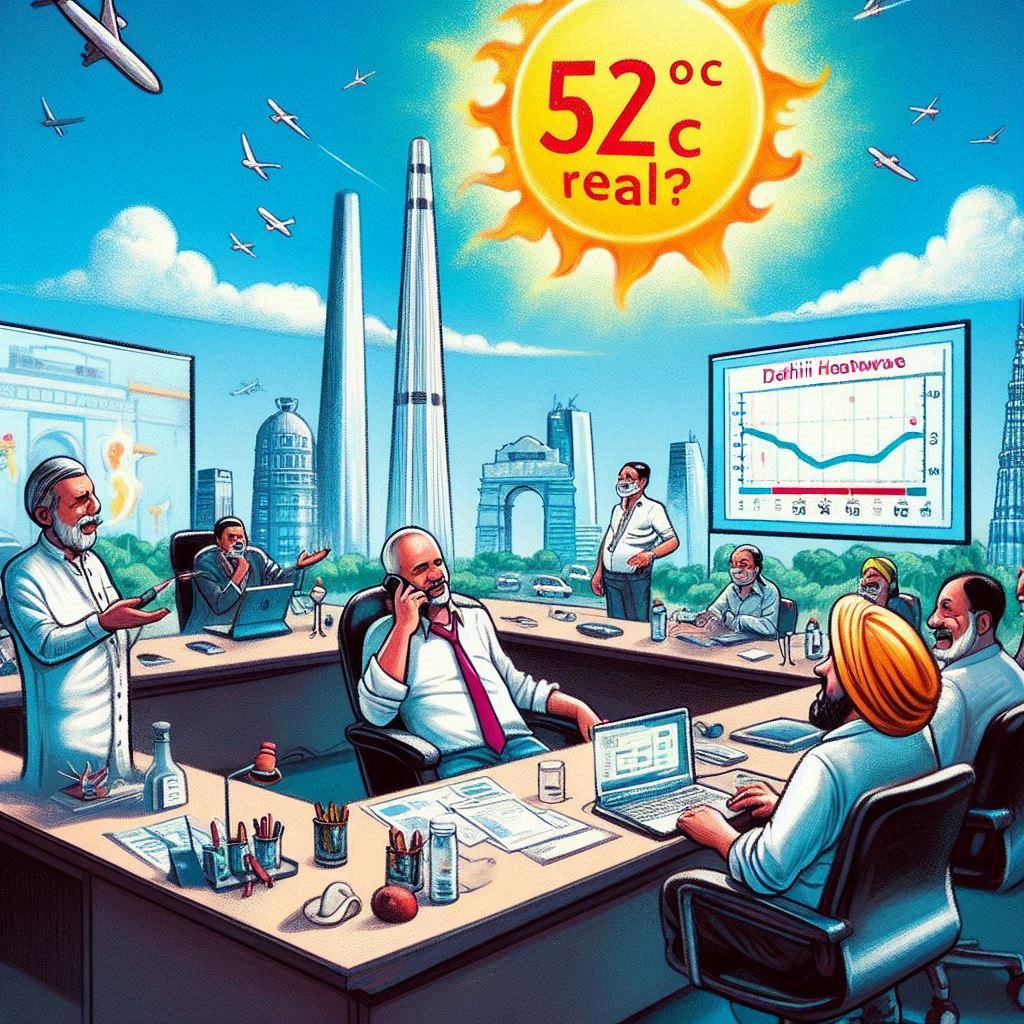IMD Investigates Unprecedented Delhi Heatwave: Is 52.9°C Real?

The India Meteorological Department (IMD) is investigating a temperature reading of 52.9 degrees Celsius recorded in Delhi today, which would be the highest-ever temperature recorded in the country. According to IMD Director General M Mohapatra, the temperature sensor at the Mungeshpur automatic weather station is being checked for accuracy. While some other observatories in Delhi have shown slightly higher temperatures, the reading from Mungeshpur needs confirmation. A team has been dispatched to inspect the temperature sensor and determine if there are any local factors contributing to the high reading.
Dr. Mohapatra emphasized that the temperature recorded at Mungeshpur is an outlier compared to other stations in Delhi, where temperatures ranged from 45.2 to 49.1 degrees Celsius. The IMD stated that the discrepancy could be due to sensor error or local factors. Earth Sciences Minister Kiren Rijiju stated that the reported temperature of 52.3 degrees Celsius is unofficial and needs verification by senior officials in the IMD.
Explaining the unusual rise in temperature, IMD regional head Kuldeep Srivastava attributed it to hot winds from Rajasthan affecting the city’s outskirts, particularly areas like Mungeshpur, Narela, and Najafgarh. The IMD issued a red alert health notice for Delhi, warning of a very high risk of heat-related illnesses.
While India experiences high temperatures during summer, climate change has exacerbated heatwaves, making them longer, more frequent, and more intense. The record-breaking heatwave has led to increased power demand as residents rely on air conditioning to cope with the extreme temperatures.
Other areas in Rajasthan and Haryana have also reported exceptionally high temperatures, with some relief expected due to moist winds from the Arabian Sea and the Bay of Bengal gradually lowering temperatures in northwest India and Uttar Pradesh.
Q&A
Q: What temperature did Delhi record recently, and why is it causing concern?
A: Delhi recently recorded a temperature of 52.9 degrees Celsius, sparking concerns due to its unprecedented nature and potential implications for public health and safety.
Q: Why is the India Meteorological Department (IMD) investigating the temperature reading in Delhi?
A: The IMD is investigating the temperature reading to ensure its accuracy and reliability, as it was recorded at the Mungeshpur automatic weather station and appears to be significantly higher than readings from other stations in Delhi.
Also Read: Ripple Effect of Mental Health in School Networks
Q: What factors could have contributed to the exceptionally high temperature reading in Delhi?
A: Local factors around the Mungeshpur area, such as geographical features or sensor malfunction, are being considered as potential contributors to the high temperature reading. Additionally, early arrival of hot winds from Rajasthan could have exacerbated the heat in certain parts of Delhi.
Q: What are the potential health risks associated with such high temperatures in Delhi?
A: Extreme heat poses significant health risks, including heat illness and heat stroke, especially for vulnerable populations such as the elderly, children, and individuals with pre-existing health conditions. The IMD has issued a red alert health notice for Delhi, urging extreme caution.
Q: How is the Delhi government and other authorities responding to the heatwave and potential health risks?
A: The Delhi government and other authorities are taking measures to address the heatwave, including issuing health advisories, providing access to cooling centers, and raising awareness about staying hydrated and avoiding outdoor activities during peak heat hours.
Q: What role does climate change play in the increasing frequency and intensity of heatwaves in Delhi and other parts of India?
A: Climate change is believed to be a contributing factor to the increasing frequency and intensity of heatwaves globally, including in India. Rising temperatures, changes in weather patterns, and urban heat island effects are among the factors exacerbating heatwaves in Delhi and other regions.
Q: How does the recent temperature reading in Delhi compare to previous records?
A: The recent temperature reading of 52.9 degrees Celsius in Delhi is significantly higher than previous records, raising concerns about the severity of the heatwave and its potential impact on public health.
Q: What measures are being taken to mitigate the effects of the heatwave on vulnerable populations?
A: Authorities are implementing various measures to mitigate the effects of the heatwave on vulnerable populations, including distributing drinking water, setting up cooling shelters, and conducting outreach programs to educate people on heat-related illnesses and preventive measures.
Q: How are utilities and infrastructure coping with the increased power demand during the heatwave?
A: Utility providers are facing challenges in meeting the increased power demand during the heatwave, particularly with the widespread use of air conditioning. Authorities are working to ensure stable electricity supply and prevent power outages during this period.
Q: What are the long-term implications of extreme heat events like heatwaves in urban areas like Delhi?
A: Extreme heat events have long-term implications for public health, infrastructure, and the environment in urban areas like Delhi. They can lead to heat-related illnesses, strain on healthcare systems, damage to infrastructure, and exacerbation of air pollution and climate change.
Also Read: Vitamin D Supplements May Help Reduce Period Pain
Q: How are communities and organizations adapting to the changing climate and increasing frequency of extreme heat events?
A: Communities and organizations are implementing adaptation strategies to cope with the changing climate and increasing frequency of extreme heat events. These strategies include urban greening initiatives, heat-resilient infrastructure development, and early warning systems for heatwaves.











